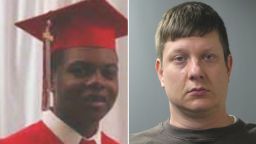Editor’s Note: Joey Jackson is a criminal defense attorney, partner at Watford Jackson, PLLC, and a legal analyst for CNN and HLN. The views expressed here are solely his. View more opinion articles on CNN.
Almost four years after taking the life of 17-year-old Laquan McDonald in a hail of 16 bullets, police Officer Jason Van Dyke was held accountable by a Chicago jury. Friday, he was convicted of murder in the second degree. What that means is that the jury concluded that he acted unreasonably and without any lawful justification.
The jury came to this conclusion after hearing testimony for more than two weeks, and after deliberating for more than seven hours.
The critical legal issue was whether Officer Van Dyke was justified in killing the African-American teen back on October 20, 2014. They concluded that he was not.
One could only wonder what Officer Van Dyke was thinking when he took McDonald’s life.
Why did he jump out of his police cruiser and start firing his service weapon in the first place – much less six seconds after arriving upon the scene? Other officers at the scene stayed in their cars. Why didn’t he? No other officers discharged their firearms. Why did Van Dyke?
What was his rush? Why didn’t he make an effort to de-escalate the situation? Why not allow McDonald more of an opportunity to comply? Why did he feel he was in danger when McDonald was so far away from him? Why did he shoot to kill when McDonald was not advancing toward him?
These are just some of the many questions that apparently troubled the jury and led to Van Dyke’s conviction.
The narrative spun by the defense was predicated upon a spirited attack on Laquan McDonald’s character that painted the deceased as a villain. Officer Van Dyke himself had pointed to what he characterized as McDonald’s bugged-out eyes that he never lost sight of, and that seemed to be “staring right through me.” Additionally, the defense highlighted the PCP that was found in McDonald’s system, his troubled youth and his failure to obey police commands to drop the knife before being shot.
In doing so, the defense sought to put McDonald on trial, while arguing that Officer Van Dyke perceived him to represent a deadly and immediate threat. It was the standard police refrain: The officer feared for his life, and the victim was a really bad guy who failed to obey commands. That line of attack was about as commonplace as police shootings of African-American men – in Chicago and across the country. And alas, it failed.
So too, did the defense fail to adequately explain why 16 bullets were necessary to end the supposed “threat” posed by the black youth. Notably, he was multiple feet away from Officer Van Dyke, with a knife, not a gun.
The jury also held Van Dyke accountable for this misconduct as well. He was found guilty of 16 counts of aggravated battery – one for each shot.
Officer Van Dyke did not do himself much good with his own testimony. His version of events includes the teen attempting to rise from the ground while still pointing the knife at the officers on the scene after being shot. Importantly, the dashcam video seems to tell entirely another story.
Recognizing this, the defense attempted to shift the focus to Officer Van Dyke’s perceptions, and away from the facts. It even presented expert testimony to explain his level of anxiety, why his perceptions might differ from reality and how any inconsistent statements he made to authorities after the shooting were understandable and excusable. Van Dyke tried to explain this inaccuracy by saying he was “in shock.” Hmmm.
And as to the knife, Van Dyke specified that McDonald raised it across his chest. The video, however, seems to show McDonald with both hands at his side. Van Dyke goes on to say that McDonald was still pointing the knife at him while on the ground. The video, however, shows McDonald lying motionless. That same video contradicts Van Dyke’s core contention that McDonald was approaching him at the time he was shot. To the contrary, the video shows him moving in a different direction.
Officer Van Dyke made still more assertions in his testimony that just didn’t seem to square with the facts. For starters, he claimed that he and McDonald never lost eye contact. Yet, the encounter happened in the dead of night and McDonald was multiple feet away. Strange how he was able to see McDonald’s eyes so well, especially given his vivid description of what McDonald was doing with the knife. Common sense would suggest that’s what Van Dyke was focusing upon.
The prosecution, for its part, pressed its theory that there was no immediate threat, and that the force used was grossly disproportionate to what the situation demanded. Nothing made that point more convincingly than the fact that there were about 10 other officers on the scene, and Van Dyke was the only one who used his weapon. Other officers provided testimony noting that they did not share Van Dyke’s fear nor safety concern. And that was damning.
The jury spoke volumes with its verdict. This time, the magic argument that an officer feared for his life and just had to shoot did not work. On these facts, it was hard to see how it would. Justice was served. Moving forward, may justice continue to be served whenever an officer dishonors their badge by failing to protect and serve.




